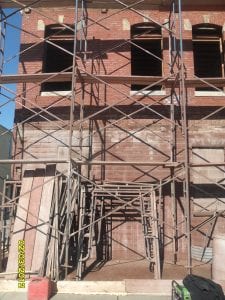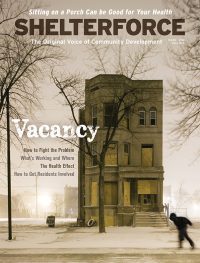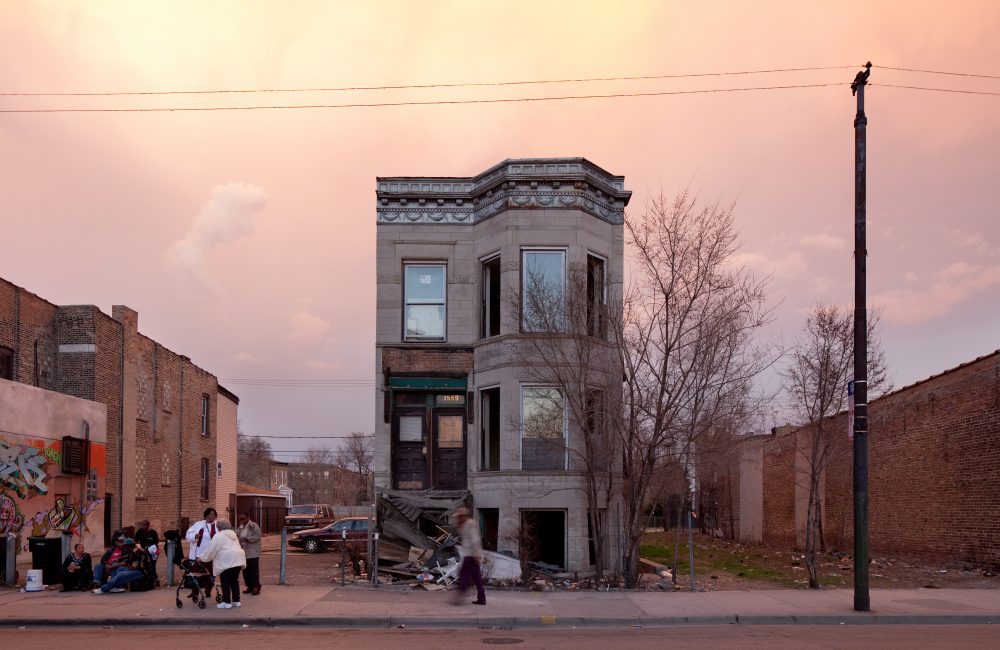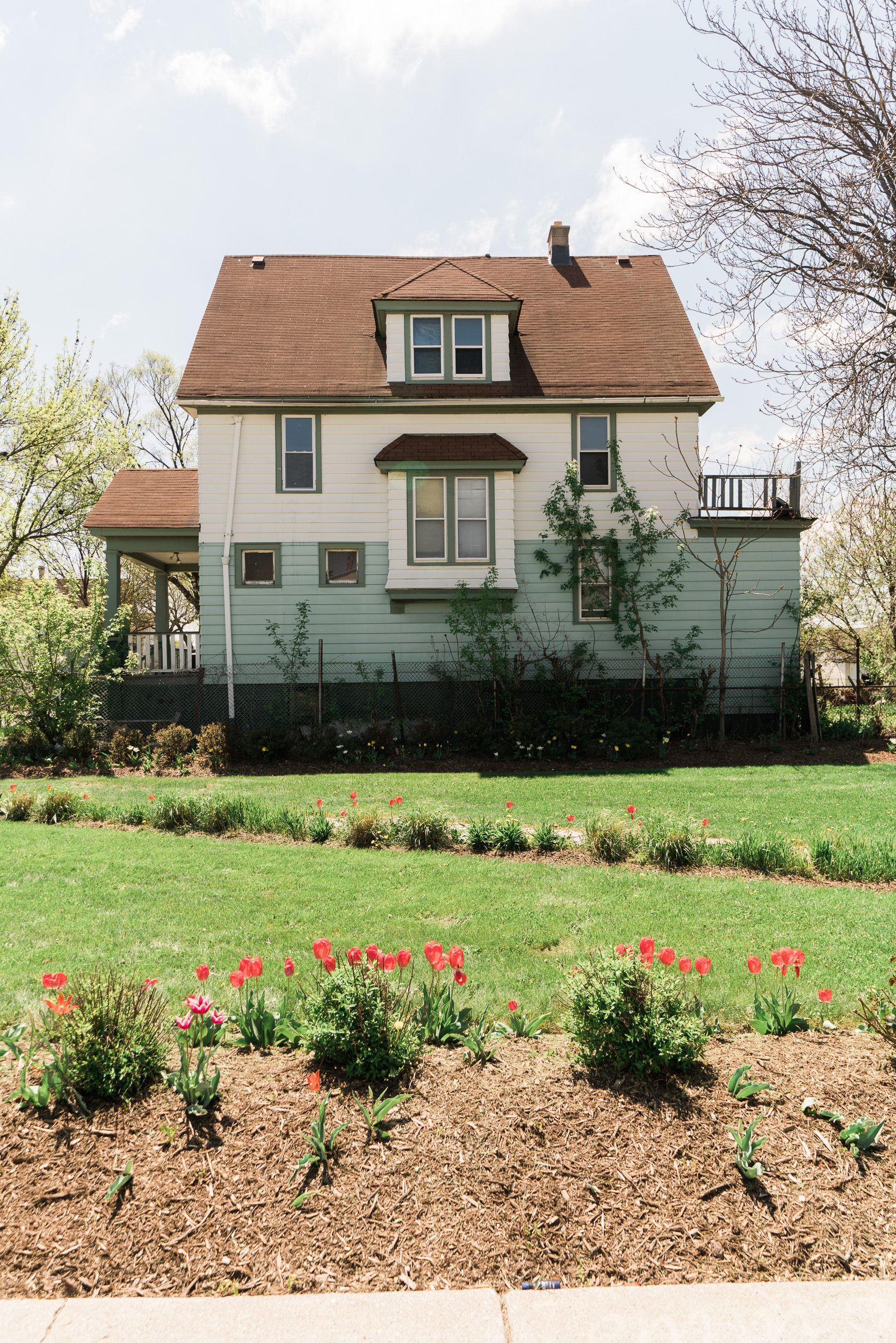*Editor’s Note: This article was updated to reflect Michael Braverman’s correct title. Baltimore Housing is no longer a combined agency that serves as the city’s housing authority and department of housing and community development. In 2017 it was separated into two entities—the Department of Housing and Community Development and the Housing Authority of Baltimore City.

An abandoned building in Baltimore is undergoing a renovation thanks to the Vacants to Value program, an initiative that launched in 2010. Photo courtesy of the Baltimore Housing
Baltimore may be known as Charm City, but there is one fact about it that is not so charming: the city’s 16,000 vacant properties. Over the last decade Baltimore has grappled with falling property values, neighborhood crime, and a declining population. However, one city program is helping to turn those numbers around. Vacants to Value is an initiative Baltimore launched in 2010. When the program began, Baltimore had 16,800 known vacant properties. Recognizing that it could help raise property values, attract new residents and businesses, and increase local tax revenue by reducing those numbers, the city launched Vacants to Value as part of then-Mayor Stephanie Rawlings-Blake’s plan to grow the city by 10,000 households by 2020.
“At that point in time, it was clear to us that we needed to be able to create a way for those properties to get back into the market where there was clearly market demand,” says Michael Braverman, the commissioner of the Department of Housing and Community Development.
Through Vacants to Value, the city sought to gain control of those properties and get them in the hands of developers who would be willing to rehabilitate them and put them back into use. Since 2010, the city of Baltimore has rehabilitated 4,200 vacant buildings (and demolished more than 2,700).
How the Vacants to Value Program Works
When Vacants to Value started, the city already controlled close to 3,000 properties, Braverman says. But another approximately 13,000 vacant properties were privately owned.
In order to get investors to take an interest in rehabilitating properties in Baltimore, those investors had to believe their time and money was worth it. At the time, an investor might have been able to buy a few properties here and there, but there wasn’t a steady stream of properties available. That meant one question the city needed to tackle was: “How could we move the vacant and abandoned privately owned inventory in a way that was predictable enough for our partners to make business decisions?” Braverman says. The city had to have a way to get abandoned properties out of the hands of wayward owners. The city’s receivership statute, which had been enacted in 1991, provided that ability.
The receivership laws allowed the city to give the owner of an abandoned property a warning, fines, and a chance to rehabilitate the property within a certain amount of time. According to Baltimore Housing, the city can give a vacant property owner a $900 fine for code violations. If after 60 days the owner takes no action, the city can then issue another $900 fine. If after another month no action is taken, the city can take the owner to housing court. If the court rules against the owner, the property enters receivership. At this point, a receiver sells the property to someone who will rehabilitate it. This process can be held up if the city has to track down the owner, such as in the case of an owner dying or simply abandoning the property.
One House at a Time is a nonprofit organization appointed by the District Court of Baltimore City as the receiver for the Vacants to Value program. “The city takes its negligent properties that they’ve declared to be in receivership, and they go to the court and they can appoint a receiver,” says Lisa R. Evans, executive director of One House at a Time. “We then take the properties to auction.”
In order to take part in the bidding process for Vacants to Value properties, buyers must meet a number of requirements.
- They must show that they have the assets to rehabilitate the property.
- They must be able to demonstrate previous experience or knowledge about real estate transactions and rehabilitating properties.
- They must be in good standing with the City of Baltimore, having no housing code or tax violations.
“They don’t have to be big developers; we have folks who do maybe one or two a year,” Evans explains. However, buyers do have to show that they are committed to the process of rehabilitating the vacant properties and putting them to use.
This process has provided the kind of long-term and predictable production scale that developers needed, says Sean Closkey, president of Rebuild Metro, a nonprofit community development organization based in Baltimore. “You understand the price of what you’re developing. You can size your financing relative to the number of units that you can do, not only this year but next year, or several years in advance,” he says. “As we’re developing the first 25 vacant houses, we can begin to work on financing for the next 25 vacant houses.”
The program also depended on finding steady access to capital for its buyers, particularly for smaller developers looking to rehabilitate only a few properties a year. Vacants to Value was coming of age during a time when banks had tightened their lending standards as the country was coming off of the 2008 housing market collapse. In Baltimore, nonprofit lending organizations, such as Baltimore Community Lending, stepped up and provided funding to many smaller developers, Braverman says, which was essential for program to work.
When all of the pieces are in place, progress continues much like an assembly line. “We have a set of units that are actively under construction, a set of units that are in pre-development, and a set of units that are in planning. Then each year, the units that were in production become occupied, those that are in development move up to production, and that allows for a consistent flow of investment into this neighborhood,” Closkey says. For example, Rebuild Metro, formerly known as TRF Development Partners, purchased 23 properties to rehabilitate in 2011, 48 properties in 2012, three properties in 2013, and 12 properties in 2014.
When developers experience success and the number of vacancies in a neighborhood starts to decline, that inspires other developers to get into the game and buy up the remaining vacant properties, Closkey adds. Between 2010 and 2015, more than 200 buyers and developers participated in the program. “It’s a market that is turning, and people want to be in a market that turns.”
Targeting the Right Neighborhoods
To start with, prospective buyers of properties need to believe they can make a profit. “At the end of the day, houses have to have at least a value equal to the cost of being developed,” says Closkey. Buyers are attracted to communities that have assets such as local businesses or institutions that provide a sense of stability for the neighborhood.
When One House at a Time first began working as a receiver more than a decade ago, the city’s approach was scattershot. One house might go into receivership from one neighborhood followed by another from a different neighborhood. In many of those cases, properties didn’t sell or they were never rehabilitated.
“Then the city tried a more targeted approach, and it clearly has worked much better,” Evans says. Vacants to Value prioritizes vacancies in parts of the city where vacancy is a problem, but a strong housing market still exists. They also look for whole-block areas within neighborhoods where a developer might be able to get their hands on a large piece of land at once. By focusing its receivership and auction activity in concentrated areas, the city can not only give developers like Rebuild Metro access to multiple properties in one area, it can often coordinate with other departments to improve the infrastructure of targeted area through projects such as street paving, Braverman says.
For a decade, Rebuild Metro has worked with the City of Baltimore to rehabilitate properties in two targeted neighborhoods. Greenmount West initially had 185 vacant properties, and Oliver had 458, Closkey says. Today, Greenmount West has fewer than 25 vacant properties and Oliver has fewer than 40.
Targeting areas where there were nearby assets and capital investment was smart, says Salem Reiner, associate director of economic development for Johns Hopkins University in Baltimore. “A lot of government programs have a tendency to go to the most troubled neighborhood and the most troubled block within that neighborhood, and say, let’s start there,” Reiner says. Vacants to Value looked for neighborhoods where there was already a foundation that could inspire development, such as an anchor institution or previous capital investment.
Organizations and institutions like Johns Hopkins have a vested interest in the issue of vacancy. “It’s in our self-interest to have a strong vibrant community around us,” Reiner says. The university has two major community development initiatives of its own, the East Baltimore Development Inc. (EBDI) and the Homewood Community Partners Initiative (HCPI), which Vacants to Value complements. In neighborhoods surrounding the university, vacancies have decreased, partly thanks to Vacants to Value, Reiner says, from 509 in 2012, to 233 in 2018.
Vacants to Value also sometimes targets places where it can offer enough properties at once to affect the market. “We’re a row-house town,” Braverman explains, so getting access to only one or two properties on a block without access to the balance can prove tricky for rehab work. If there is a whole vacant block in a promising area, the city will prioritize bringing all of those properties into the program.
“If you’re going to sell them, you have to have a community with some sort of a market or you have to have enough bulk to create the market,” Evans says.
Results
In 2015, the city commissioned an evaluation of the program, which was performed by the Center for Community Progress in partnership with the Baltimore Neighborhood Indicators Alliance and the University of Baltimore’s Schaefer Center. One of the strengths of the program, the study found, was the fact that the city had managed to encourage development without offering much in the form of public subsidies.
“Baltimore City has gotten very good at moving certain properties that are viable for development out of the hands of people that are not doing anything with it and into the hands of somebody that can,” says Seema D. Iyer, associate director of the Jacob France Institute in the University of Baltimore’s Merrick School of Business, who has overseen the Baltimore Neighborhood Indicators Alliance.
Every program has strengths and weaknesses, and Vacants to Value has had its share of critics. Earlier this year, a Baltimore Sun investigation criticized the program because there were 16,800 vacant houses in Baltimore in 2010, and there were 16,500 vacant houses in 2018. Some use those numbers to say that the program has not made a difference. Others say that while some Baltimore neighborhoods have seen an improvement, others have not.
But that criticism is unfounded, supporters says. “That’s not accounting for the rate at which vacancies multiply,” says Closkey. Without Vacants to Value or another plan to target the vacancy problem, the city would likely have tens of thousands more vacancies by now, he adds.
The number of rehabilitated properties should not be a measure of success, Evans says. If 15 properties have been rehabbed in scattered parts of the city, but the surrounding neighborhoods didn’t improve, you haven’t been successful. “But if you did 15 and you did it in a three-block radius, and something happened in [those] three blocks, you were very successful.”
Rehabilitating a house has a multiplying effect, Closkey says. “Every time we rehab a house, we positively affect the two neighboring houses too.”
Iyer agrees that because there are always new properties being abandoned, “you’re always taking one step forward, two steps back.” Also, what works in one neighborhood might not work in another. “What we found is that in some neighborhoods, that one step forward was exactly what that neighborhood needed, and then they could take their own step forward. In other neighborhoods that one step just isn’t enough. And so those neighborhoods need Vacants to Value to be coupled with other things.” For example, efforts to help existing homeowners to maintain their homes could keep the number of vacancies from rising in some neighborhoods, Iyer says.
Moving the Program Forward
While Vacants to Value began under a different administration, the current mayor, Catherine Pugh, has continued to offer support for the idea of cleaning up the city’s vacancies. In her annual State of the City address earlier this year, Pugh said the city wanted to demolish 1,000 buildings. In conjunction with the state of Maryland, her administration also launched a new program called Project C.O.R.E., or Creating Opportunities for Renewal and Enterprise, which seeks to demolish vacant buildings while creating new green space and affordable and mixed-use housing. Project C.O.R.E. will not replace Vacants to Value; rather it will work in conjunction with Vacants to Value and will provide more funding to demolition efforts. The state of Maryland will contribute $75 million and the city of Baltimore will contribute $18.5 million to the efforts.
Because of that extra funding, Project C.O.R.E. could take Vacants to Value to the next level, Braverman says. It could provide money for subsidies to incentivize residents to become homeowners. Currently, Vacants to Value has a booster program that gives homebuyers $10,000 toward closing costs if they purchase a home that was formerly vacant. More than 360 homebuyers had benefited from the closing-cost assistance by 2016. “That sweetener has helped our homeownership side considerably,” says Braverman, but it’s not always enough. With more money for subsidies available, homebuyers could be given incentives to move into Baltimore rather than moving into the suburbs beyond the city’s borders.
As the Vacants to Value program builds upon its successes, “it is important for us to be intentional about what outcomes we are looking for over time,” Braverman says. Desired outcomes include improving the welfare of legacy residents, creating an appropriate mix of affordable housing, and understanding how to leverage homeownership outcomes where that’s important, he adds.
Replication
Another question that arises when looking at the success of the program: Can Vacants to Value be replicated by another city that’s facing a similar challenge of out-of-control vacancies?
“All cities are unique,” says Reiner. The Vacants to Value model could work in another city but it has to be customized to that particular region. “It’s not going to be a plug-and-play.”
In order for another jurisdiction to take advantage of a program like this, it would need a tool like Baltimore’s receivership statute, which would allow it to take control of a particular property, Iyer says. Without the ability to get vacant properties out of the hands of absentee owners, a city wouldn’t be able to build trust among developers that they could gain steady access to the amount of inventory that would make rehabilitation worthwhile.
Other cities—including Baltimore—should look at the lessons from Vacants to Value, but they should also come up with ways to get to the root of the problem, Iyer says. “Vacants to Value is an amazing program that looks, unfortunately, at the tail end of that life cycle of the building, which is when the vacancy has already occurred. We need way more resources to prevent vacancies from happening to begin with.”
However, Reiner does believe that there is an opportunity for other cities to benefit from all that has been learned from the Vacants to Value program. Sure, they may have to tweak the program for their own unique needs, but they should be inspired that one city has managed to put a dent in a problem that had been plaguing it for so long. “Baltimore is a successful example,” he says. “If Baltimore, with all its challenges, can do this, others can also.”






Shelterforce
60 S. Fullerton Ave., #202
Montclair, NJ 07042
To Whom It May Concern:
We read with great interest Tamara Holmes’ article about Baltimore’ s vacant houses (“Making a Pipeline for Vacant Building Rehab”, 11/13/18). Ms. Holmes highlights a City program, Vacants to Value (V2V), which was initiated in 2010 and claims to have rehabilitated 4,200 vacant buildings while demolishing more than 2,700. She relies on the City government’s assertions, as well as an evaluation commissioned by the City from the Center for Community Progress. Alas, a bit more investigating might have provided your readers with a more thorough and critical analysis of Vacants to Value and its context: the desperate housing situation in Charm City.
As the developers and public officials interviewed by Ms. Holmes state (without clarifying), the purpose of the Vacants to Value program is NOT to improve the housing situation in Baltimore, a city where 92,186 households (38.6%) are cost-burdened, thousands of people are homeless on any given day, and the waiting list for subsidized housing is closed. Rather, V2V targets certain buildings in specific neighborhoods to increase the exchange value of these buildings and secure profits for the new owners. The program is an excellent example of neoliberalism: using the authority and resources of the public sector not in the service of justice and equality, but rather to facilitate profit-taking in the market.
As longtime affordable housing advocates, we have long been critical of V2V because it fails to create any housing affordable to the tens of thousands of impoverished people in a city that is so desperately poor. When pressed, City officials will agree that V2V was not designed to solve the most important housing problem in Charm City: an intolerable lack of housing for ordinary Baltimoreans. Annually landlords file for more eviction notices in Baltimore than there are renter households ; shelters are full 100% of the time and all well traveled thoroughfares have people of all ages and races begging for money on every corner.
Rather than attempt to address these problems, V2V assists developers, large and small, to acquire unoccupied buildings in neighborhoods that are categorized as stressed, but salvageable – in the words of the article, “Targeting the Right Neighborhoods”. The program does not operate in the most distressed neighborhoods, home to people with the most desperate need, because profits are unlikely to be made there. Geographic factors, such as location near an “anchor institution” (perhaps a university or hospital), are considered, as are physical characteristics. The goal is to facilitate developers in producing housing that can be sold to a buyer who does not require a deep subsidy. To our knowledge, however, not a single housing unit targeted to low income and/or homeless families has been produced by V2V.
The receivership mechanism of One House At A Time, described by Ms. Holmes, is a conduit for developers looking to make profits, nothing more. Low-income communities gain nothing from new investors gobbling up vacant houses, rehabbing them, and renting or selling them at market rate. A consequence, perhaps unintended and perhaps not, is to make these neighborhoods more expensive and more white.
Better use of vacant houses whose owners are delinquent on their taxes or utilities AND city-owned vacant houses could include:
➢ Donating the properties to a Community Land Trust, which would ensure that the houses remain rentable by low or moderate income families and would ensure community control;
➢ Creating a program that employs ex-offenders people experiencing homelessness to rehab the homes and then rents them to poor families whose income is at or below 30% of Baltimore’s AMI;
➢ Permitting non-profit organizations to develop the homes for low-income families and individuals;
➢ Implementing a public bank empowered to invest in affordable housing;
➢ Reinvigorating a “Dollar House” program with long-term low-interest loans and other funding streams to promote home ownership for working families.
Finally, the statistics bandied about by City officials must be taken with an extra-large helping of salt. Baltimore City government claims that there are 16,000 vacant houses here, but the U.S. Census Bureau counts 46,782 . A 2015 study of Vacants to Value written by ace journalist Joan Jacobson and published by the Abell Foundation determined that the City “has overstated the reach of Vacants to Value and that the program was not the catalyst for the redevelopment of hundreds of buildings included in the city’s list of 1,585 properties. In more than 200 cases, owners had no building permits for renovation to prove when or if repairs were actually made, while hundreds more with building permits began years before Vacants to Value started. In addition, nearly 300 houses purported to be part of Vacants to Value’s success were purchased by investors on the private market and had no involvement with the program.”
To conclude her article, Ms. Holmes quotes a Johns Hopkins University official: “…there is an opportunity for other cities to benefit from all that has been learned from the Vacants to Value program. Sure, they may have to tweak the program for their own unique needs, but they should be inspired that one city has managed to put a dent in a problem that had been plaguing it for so long. ‘Baltimore is a successful example,’ he says. ‘If Baltimore, with all its challenges, can do this, others can also.’”
Indeed Baltimore is a successful example if “success” is defined as developers’ profits and gentrified neighborhoods. If, however, “success” means reducing the numbers of our neighbors who are ill-housed and homeless, other models must be explored. Justice assuredly flows through a very different pipeline.
Lauren Siegel and Jeff Singer, University of Maryland School of Social Work
Thank you so much for your comment.